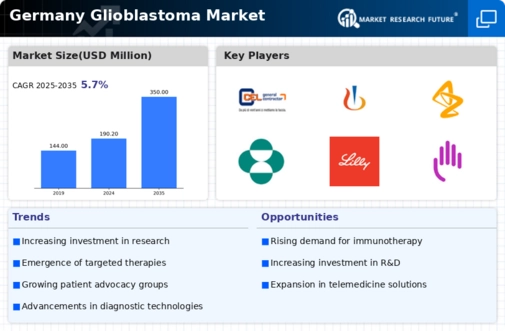Rising Incidence Rates
The glioblastoma market in Germany is experiencing growth due to the rising incidence rates of glioblastoma. Recent statistics indicate that the age-standardized incidence rate for glioblastoma in Germany is approximately 3.2 per 100,000 individuals. This increase in cases necessitates the development of new treatment options and therapies, thereby driving market expansion. The growing awareness of glioblastoma symptoms among the population also contributes to earlier diagnosis, which is crucial for effective treatment. As the healthcare system adapts to these rising numbers, investments in research and development are likely to increase, further propelling the glioblastoma market. The need for innovative solutions to address this aggressive form of brain cancer is becoming increasingly urgent, suggesting a robust future for the market in Germany.
Government Initiatives and Funding
Government initiatives and funding play a crucial role in shaping the glioblastoma market in Germany. The German government has been actively promoting research and development in oncology, particularly for aggressive cancers like glioblastoma. Funding programs aimed at supporting clinical trials and innovative treatment approaches are becoming more prevalent. For instance, the Federal Ministry of Education and Research has allocated substantial resources to cancer research, which includes glioblastoma studies. This financial backing is likely to encourage collaboration between academic institutions and pharmaceutical companies, fostering the development of novel therapies. As a result, the glioblastoma market is expected to benefit from increased investment in research, leading to the introduction of new treatment modalities and improved patient outcomes.
Growing Patient Advocacy and Awareness
The glioblastoma market in Germany is also influenced by the growing patient advocacy and awareness initiatives. Organizations dedicated to brain cancer awareness are actively working to educate the public about glioblastoma, its symptoms, and the importance of early diagnosis. This heightened awareness is likely to lead to increased patient engagement in treatment decisions and clinical trials. Furthermore, advocacy groups are pushing for more funding and research into glioblastoma, which may result in the development of new therapies and improved care standards. As patients become more informed and involved, the demand for innovative treatment options is expected to rise, thereby driving growth in the glioblastoma market. The collaboration between patients, healthcare providers, and researchers is essential for advancing treatment strategies and improving outcomes.
Advancements in Diagnostic Technologies
Technological advancements in diagnostic tools are significantly impacting the glioblastoma market in Germany. Enhanced imaging techniques, such as MRI and PET scans, allow for more accurate and timely diagnosis of glioblastoma, which is essential for effective treatment planning. The integration of artificial intelligence in imaging analysis is also emerging, potentially improving diagnostic accuracy and patient outcomes. As these technologies become more widely adopted, they are likely to facilitate earlier detection of glioblastoma, which can lead to better prognosis and treatment options. Consequently, the demand for advanced diagnostic solutions is expected to rise, thereby stimulating growth in the glioblastoma market. The ongoing development of biomarkers for glioblastoma is another area of focus, which may further enhance diagnostic capabilities and treatment personalization.
Emergence of Innovative Treatment Modalities
The emergence of innovative treatment modalities is a key driver for the glioblastoma market in Germany. Recent developments in immunotherapy, targeted therapies, and personalized medicine are reshaping the treatment landscape for glioblastoma. For instance, the introduction of CAR T-cell therapy and checkpoint inhibitors has shown promise in clinical trials, potentially offering new hope for patients with this aggressive cancer. The market is witnessing a shift towards more individualized treatment approaches, which may enhance efficacy and reduce side effects. As these innovative therapies gain traction, they are likely to attract significant investment from pharmaceutical companies, further stimulating the glioblastoma market. The ongoing research into combination therapies also suggests a potential for improved outcomes, making this an exciting time for advancements in glioblastoma treatment.
























Leave a Comment